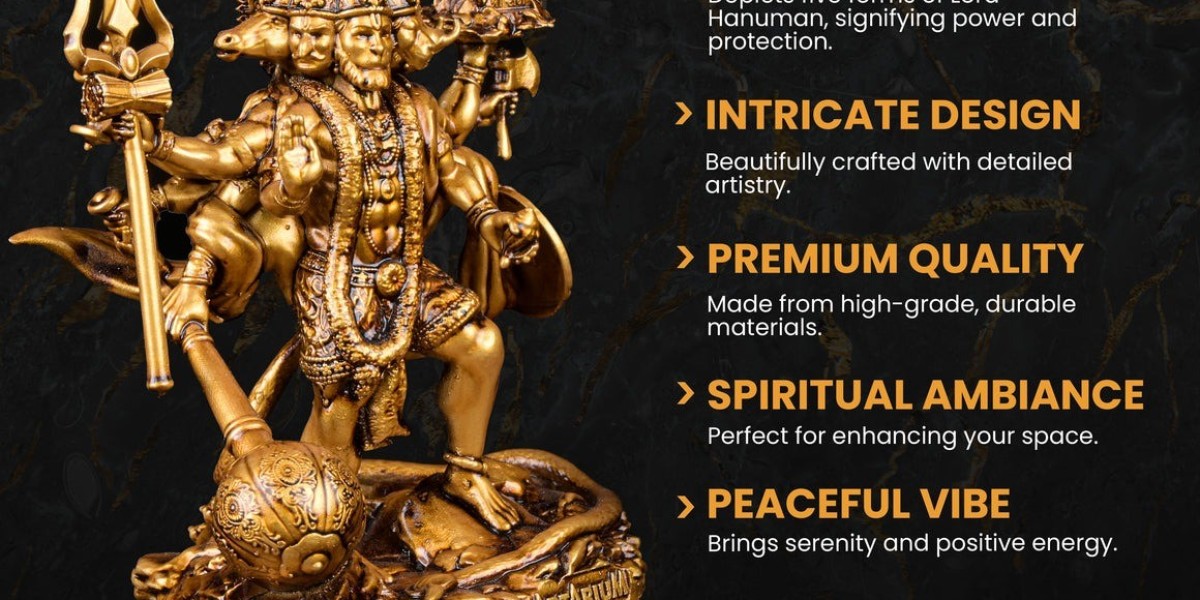5 Mukhi Bajrangbali, also known as Panchamukhi Hanuman, represents a unique and powerful aspect of Lord Hanuman. Revered in Hindu mythology, this form symbolizes the multifaceted nature of divine energy, embodying various qualities that offer protection, strength, wisdom, and devotion. The significance of Bajrangbali is particularly emphasized in spiritual practices, where devotees seek blessings for overcoming obstacles and achieving success in their endeavors. In this article, we explore the attributes and significance of 5 Mukhi Bajrangbali, along with the benefits of worshipping this divine form.
The Concept of Five Faces
The term "Panchamukhi" literally means "five-faced." Each face of Bajrangbali represents a specific aspect of life and spirituality:
- Hanuman (East-facing)
- Narasimha (South-facing)
- Garuda (West-facing)
- Varaha (North-facing)
- Hayagriva (Skyward-facing)
1. Hanuman (East-facing)
The East-facing face of Bajrangbali represents Lord Hanuman in his most revered form. This aspect embodies devotion, strength, and loyalty. Worshipping this face inspires courage and instills confidence, helping devotees overcome fear and adversity. Hanuman's dedication to Lord Rama is a powerful example of unwavering loyalty and selfless service.
2. Narasimha (South-facing)
The South-facing face is that of Narasimha, the fierce incarnation of Lord Vishnu. This aspect signifies protection and the destruction of evil. Narasimha's energy is invoked to confront negativity and provide devotees with the strength to face challenges head-on. This face serves as a source of empowerment, encouraging followers to confront their fears and stand against injustice.
3. Garuda (West-facing)
Garuda, the celestial bird and vehicle of Lord Vishnu, is depicted in the West-facing aspect. This face symbolizes speed, agility, and liberation from bondage. Garuda's blessings are sought for overcoming obstacles and swiftly achieving goals. Worshippers believe that invoking Garuda’s energy provides protection against harmful influences and promotes overall well-being.
4. Varaha (North-facing)
The North-facing face represents Varaha, the boar incarnation of Lord Vishnu, who is known for rescuing the Earth from the demon Hiranyaksha. This aspect symbolizes stability, prosperity, and material abundance. Devotees who seek financial security and stability often pray to Varaha, believing that this face can help remove obstacles related to wealth and prosperity.
5. Hayagriva (Skyward-facing)
Hayagriva, with the head of a horse, represents knowledge, wisdom, and intellectual pursuits. This aspect is especially revered by students and scholars seeking academic success. Worshipping Hayagriva illuminates the mind, enhances learning, and removes ignorance. This face emphasizes the importance of wisdom in achieving one’s goals and aspirations.
Spiritual Significance
The worship of 5 Mukhi Bajrangbali provides devotees with a comprehensive approach to spirituality. Each face serves as a reminder of the diverse qualities that individuals can cultivate within themselves. By honoring this form, devotees can seek blessings for physical strength, mental clarity, protection, and financial stability. The multifaceted nature of Bajrangbali highlights the interconnectedness of various aspects of life, encouraging followers to seek balance and harmony.
Rituals and Practices
Devotees engage in various rituals to honor 5 Mukhi Bajrangbali, including:
- Recitation of Mantras: Chanting specific mantras associated with each face invokes their respective energies and blessings.
- Abhishekam: Ritual bathing of the idol with sacred substances, symbolizing purification and reverence.
- Offerings: Presenting flowers, fruits, and sweets as expressions of devotion and gratitude.
Festivals and Celebrations
Bajrangbali is celebrated during various festivals, particularly Hanuman Jayanti, which marks the birth of Lord Hanuman. During this time, temples host special events, including processions, cultural programs, and community gatherings, attracting large crowds of devotees who come to seek blessings and participate in festivities.
Conclusion
5 Mukhi Bajrangbali embodies the essence of divine attributes that guide devotees on their spiritual journey. Each face represents unique qualities and blessings, offering protection, strength, wisdom, and prosperity. Through worship and devotion, followers can harness the energies of this five-faced avatar, cultivating resilience and enlightenment in their lives. Bajrangbali serves as a powerful reminder of the interconnectedness of various aspects of life, encouraging devotees to embrace both their strengths and challenges with faith and dedication.



